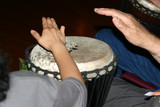Call and Response Drumming
Drumming within a drum circle or leading a therapeutic drumming environment requires the ability of the facilitator to keep the drumming interesting as well as easy for the novice drummer or for those with physical or other limitations. Complex rhythms, while fun and inspirational, can cause the participants to shy away from drumming, feeling overwhelmed in terms of the ability needed to play, or even causing sensory overload for more sensitive participants. A time-honored drumming technique, “call and response” drumming, can help a drum circle facilitator achieve goals within the drumming activity while giving participants the confidence needed to benefit from drumming.
"Call and response drumming," also known as “talking drums,” is a repetition of simple drum rhythms that are first played by the facilitator and then echoed by, or responded to, by the rest of the drumming group. To begin, the therapist, teacher or drum circle facilitator starts the rhythm by playing a simple beat on a djembe, doumbek or other hand percussion instrument. Per the instructions, the other participants try to replicate the rhythm, or respond with a similar beat, essentially emulating the natural sound of a verbal conversation. This technique works well within small or large groups, as well as between two people, and can benefit non-verbal and verbal communication as well as overall comfort within a drum circle or other environment.
Call and response rhythms and songs can be found in all cultures, and all types of music. Tribes in Africa would beat a djembe or similar drum to establish location and intention while traveling or during various ceremonies and festivals that celebrate important moments in the lives of tribe members. Once African culture was integrated within Latin culture, these “call and response” beats evolved into more well-known rhythms such as the Burru or Bomba, as well as many other standardized rhythms that are still used today in festivals, ceremonies and even in popular music.
Drum circle facilitators and those who use drumming in a therapeutic or community environments have a duty to keep the drum circles active and interesting. Whether a teacher or therapist is charged with using drums to achieve wellness goals or a community drum circle is starting up or trying to attract new members, keeping the drumming activities simple may benefit the participants as a whole. Utilizing “call and response” drumming can benefit the drum circle or therapeutic environment, helping with the comfort level of participants as well as the health and wellness benefits of the drumming environment.
Recent Posts
-
X8 Drums Play-Along Backing Tracks
The new X8 Play-Along Series is being produced for our musician friends wanting a fresh way to work …9th Feb 2025 -
What is the Best Size Djembe for Beginners?
If you're new to the world of percussion and interested in learning the djembe, you're in for a t …16th Jul 2024 -
The Benefits of Becoming a Drumming Teacher: Transforming Passion into Profession
Why become a drumming teacher? Becoming a drumming teacher is an excellent way to share your pas …22nd May 2024



